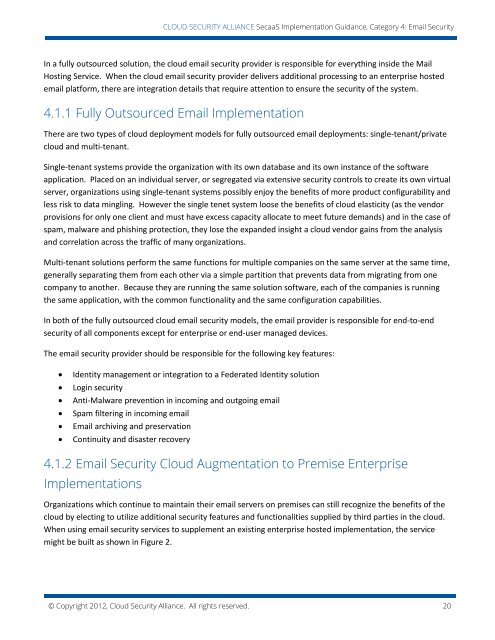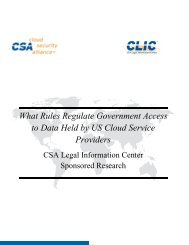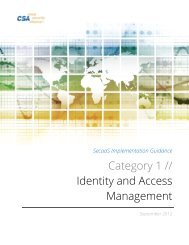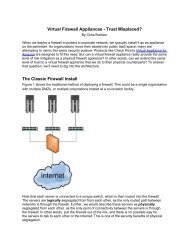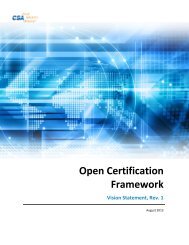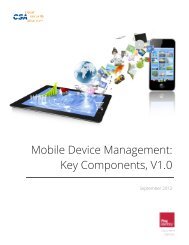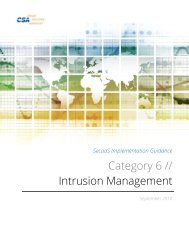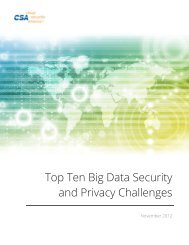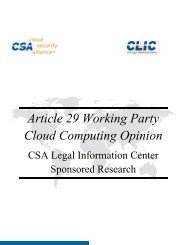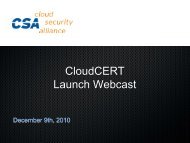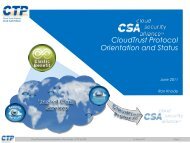Email Security Implementation Guidance - Cloud Security Alliance
Email Security Implementation Guidance - Cloud Security Alliance
Email Security Implementation Guidance - Cloud Security Alliance
- No tags were found...
You also want an ePaper? Increase the reach of your titles
YUMPU automatically turns print PDFs into web optimized ePapers that Google loves.
CLOUD SECURITY ALLIANCE SecaaS <strong>Implementation</strong> <strong>Guidance</strong>, Category 4: <strong>Email</strong> <strong>Security</strong>In a fully outsourced solution, the cloud email security provider is responsible for everything inside the MailHosting Service. When the cloud email security provider delivers additional processing to an enterprise hostedemail platform, there are integration details that require attention to ensure the security of the system.4.1.1 Fully Outsourced <strong>Email</strong> <strong>Implementation</strong>There are two types of cloud deployment models for fully outsourced email deployments: single-tenant/privatecloud and multi-tenant.Single-tenant systems provide the organization with its own database and its own instance of the softwareapplication. Placed on an individual server, or segregated via extensive security controls to create its own virtualserver, organizations using single-tenant systems possibly enjoy the benefits of more product configurability andless risk to data mingling. However the single tenet system loose the benefits of cloud elasticity (as the vendorprovisions for only one client and must have excess capacity allocate to meet future demands) and in the case ofspam, malware and phishing protection, they lose the expanded insight a cloud vendor gains from the analysisand correlation across the traffic of many organizations.Multi-tenant solutions perform the same functions for multiple companies on the same server at the same time,generally separating them from each other via a simple partition that prevents data from migrating from onecompany to another. Because they are running the same solution software, each of the companies is runningthe same application, with the common functionality and the same configuration capabilities.In both of the fully outsourced cloud email security models, the email provider is responsible for end-to-endsecurity of all components except for enterprise or end-user managed devices.The email security provider should be responsible for the following key features:• Identity management or integration to a Federated Identity solution• Login security• Anti-Malware prevention in incoming and outgoing email• Spam filtering in incoming email• <strong>Email</strong> archiving and preservation• Continuity and disaster recovery4.1.2 <strong>Email</strong> <strong>Security</strong> <strong>Cloud</strong> Augmentation to Premise Enterprise<strong>Implementation</strong>sOrganizations which continue to maintain their email servers on premises can still recognize the benefits of thecloud by electing to utilize additional security features and functionalities supplied by third parties in the cloud.When using email security services to supplement an existing enterprise hosted implementation, the servicemight be built as shown in Figure 2.© Copyright 2012, <strong>Cloud</strong> <strong>Security</strong> <strong>Alliance</strong>. All rights reserved. 20


